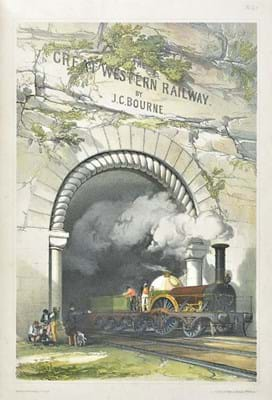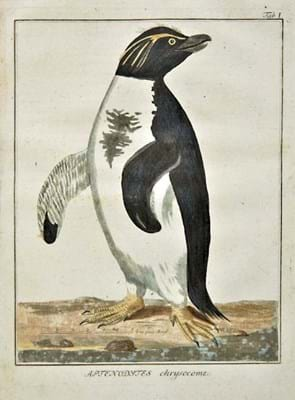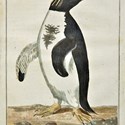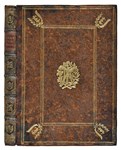Fine bindings, busy bees, early electrical experiments, a pocket atlas of the stars, Einstein and penguins all featured in a recent Gloucestershire auction.
A copy in rebacked contemporary calf of the first pocket celestial atlas published in England sold for £4600 in an April 11 sale held by Dominic Winter (20% buyer’s premium).
Dated to c.1690, this was a second edition of John Seller’s work, but a single letter alteration to the spelling of the title, as Atlas Coelestis, and an amended second state of the table showing the dates of the new and full moons up to 1700 are the only changes to the 1680 first edition.
The work contains a total of 61 engraved celestial charts, tables and diagrams, the majority of them double-page.
Formerly in the library of the Earl of Mexborough, an 1815 first of the Ackermann History of the University of Cambridge… that sold for £3400 was in a period binding of diced calf gilt with “sympathetic” morocco replacement backs. It also sported contemporary fore-edge paintings to each of the four volumes, with King’s College, Cambridge, and Syon House in London among the scenes depicted.
It concerns penguin species observed in New Zealand and the Antarctic regions. Seen here is one of the five engraved and coloured plates that illustrate his article. Estimated at £150-200, the lot sold at £3600.
Used to splendid effect on the cover of the South Cerney sale catalogue was the extra hand-coloured litho title-page of an 1846 first of John C Bourne’s History and Description of the Great Western Railway… that sold at £2800. This and the other 49 coloured plates that illustrate the work were preserved in this copy in a modern binding of half-green morocco gilt by Sotherans.
A 1634, third edition of Charles Butler’s famous bee book, The Feminin Monarchi…, made £1950 in the Dominic Winter sale.
Not for the first time in the saleroom’s dealings with apian literature, a job lot made a much higher than expected sum. Among the 60 or so books that made up a lot estimated at £100-150, but sold for £1750, there may have been something that two or more bidders were missing in their collections.
The only three works noted in the catalogue, all firsts, were WC Cotton’s My Bee Book of 1842; Samuel Simmins’ Modern Bee Farm… of 1887 (illustrated with four mounted photographs) and TM Howatson’s The Apiarian’s Manual… of 1827.
However, the book that stirred up the bee bidding battle may have been something else entirely.
Occasionally spotted and browned in a very rubbed and cracked, but contemporary binding of half calf and marbled boards, a 1769 edition of Benjamin Franklin’s Experiments andObservations on Electricity was sold for £8600. This was a fourth and first collected edition of this famous work.
“It sold for £2600, principally on the strength of a brief inscription in the hand of one of its co-authors, Albert Einstein
Among many maps on offer was a copy of Andrew Bryant’s large-scale Map of the County of Suffolk of 1826. Sold at £1400, this sectionalised, two-sheet coloured engraved map, the two parts together measuring roughly 5 x 6ft (1.5 x 1.95m) overall, folded into a calf covered bookform box.
Sold at £4200 rather than the suggested £200-300 was a four-volume ‘Delegates’ version of the New and Old Testament in Chinese.
Printed in Shanghai in 1855, it was still in its original stitched and plain mulberry paper wrappers, but also bore assorted stamps of the library of King’s College, London. The bible was contained in a now worn and damaged but contemporary calf chemise with brass clasp.
A 1938 Cambridge first of The Evolution of Physics that sold for £6200 did so principally on the strength of a brief inscription in the hand of one of its co-authors, Albert Einstein.
This copy of a work he wrote with Leopold Infeld had been given in 1941 by Einstein to Canadian-born Dr Leonard G Rowntree. In the years immediately preceding the First World War, Rowntree had, along with his colleague Benjamin Turner, built the first functioning dialysis machine and created the first artificial kidney. This was a field of medical study in which Einstein had a particular interest.


















